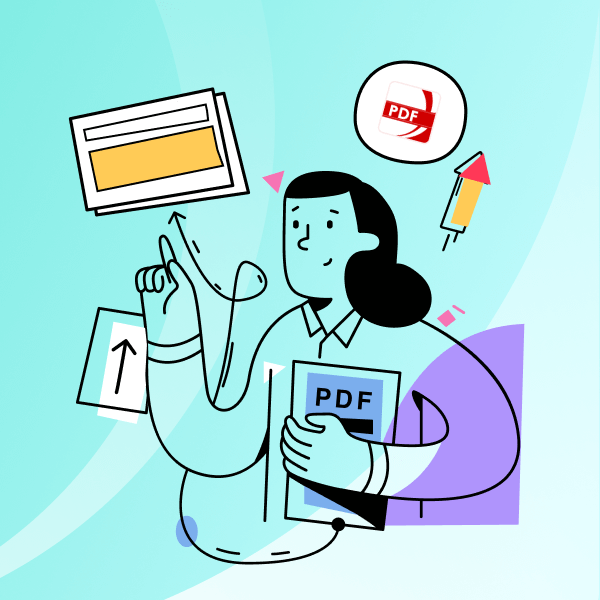Navigating through the complexities of PDF editing can be a challenging task, especially when dealing with intricate vector graphics. Adobe Illustrator, a leading vector graphics editor, provides a robust solution for making precise and creative changes to your PDFs.
This post will guide you through a streamlined process to edit PDFs in Illustrator, ensuring your documents achieve the professional and polished look you desire. Here's how you can harness the power of Illustrator to edit the vector artwork in your PDF files.
How to Edit PDF in Illustrator
Below you'll find our comprehensive guide to editing PDFs using Illustrator.
Step 1: Open Your PDF File in Adobe Acrobat
Step 2: Choose "Edit PDF" from the Right Hand Panel
Step 3: Select the Vector Artwork You'd Like to Change
Step 4: Right- (or Control-) Click and Edit Using Adobe Illustrator
Step 5: Make Your Changes to the Graphic Without Changing Anything Else
Step 6: Save Your Changes
Step 7: Confirm Your Changes in Your Open Acrobat Document

Why Edit a PDF in Illustrator?
Editing a PDF in Adobe Illustrator is often necessary for several reasons, particularly when dealing with complex vector graphics or when precise, detailed modifications are required.
Illustrator provides a robust set of tools specifically designed for manipulating graphic elements that standard PDF editors might not offer. We also have a great guide to editing PDFs without Adobe Acrobat.
Here are some compelling reasons why you might choose to edit a PDF in Illustrator:
-
Vector Graphic Adjustments: PDFs often contain vector graphics that need tweaking, resizing, or color adjustments. Illustrator excels at these tasks, offering precise control over vector shapes, lines, and colors.
-
Quality Retention: When editing graphics, retaining quality is paramount. Illustrator allows you to edit graphics without losing clarity or quality, ensuring the end result is as sharp and professional as the original.
-
Complex Modifications: Sometimes, a PDF requires complex graphical edits that go beyond basic cropping or resizing. Illustrator provides advanced tools for adding effects, texturing, or completely revamping graphical elements.
-
Brand Consistency: For business or branding purposes, you may need to update logos, color schemes, or other brand-related graphics within a PDF. Illustrator ensures that these edits align with your visual brand identity, maintaining consistency across your documents.
-
Creative Freedom: Illustrator opens up a wide range of creative possibilities, from redesigning elements to creating entirely new graphics within the PDF. This is particularly useful for designers looking to add a unique touch to standard documents.
-
Integration with Other Adobe Tools: If you're already using Adobe tools, editing a PDF in Illustrator ensures seamless integration and workflow between different applications, such as Adobe Acrobat and Photoshop, enhancing efficiency and productivity.
By editing a PDF in Illustrator, you're leveraging a powerful graphic editing tool capable of making precise, high-quality adjustments. Whether you're a professional designer looking to fine-tune a document or someone looking to make significant graphical enhancements, Illustrator provides the necessary tools to transform your PDFs into polished, professional documents.
Check out our detailed guide on how to extract tables from a PDF for easy data analysis.
How to Edit PDFs With a PDF Tool
Editing PDFs doesn't have to be daunting, especially when you have the right tools at your disposal.
PDF Reader Pro emerges as a powerful, innovative tool offering a wide array of features to efficiently manage and edit PDF documents. Here's how you can utilize PDF Reader Pro to edit PDFs with ease and precision.
1. Familiarize Yourself with the Interface: Upon opening PDF Reader Pro, take a moment to familiarize yourself with its user-friendly interface. The intuitive design makes navigation simple, ensuring that all the tools you need are within easy reach.
2. Open Your PDF File: Start by opening the PDF file you wish to edit. PDF Reader Pro supports a drag-and-drop feature for quick file opening, or you can choose your file through the open dialogue box.
3. Access Editing Tools: Once your file is open, explore the variety of editing tools available. PDF Reader Pro offers everything from text editing and annotation to adding images and shapes. The tools are designed to cater to both minor adjustments and major edits.
4. Edit Text and Images: To edit text, simply click on the text field and start typing. If you need to insert or adjust images, click on the image tool and select the image you wish to modify. PDF Reader Pro makes it easy to resize, rotate, and reposition elements within your document.
5. Utilize Advanced Features: For those needing more than basic edits, delve into the advanced features of PDF Reader Pro. This includes adding or removing pages, merging PDFs, encrypting documents, and more. The software also offers features like OCR (Optical Character Recognition) to edit scanned documents.
If you ever need to edit text in a PDF, check out our complimentary guide.
How to Edit a PDF in Illustrator: Best Practices
When it comes to editing a PDF in Illustrator, adhering to best practices is key to ensuring a smooth and successful modification process.
From handling file formats to manipulating vector graphics, every step you take should be deliberate and informed. Here are some best practices to consider when editing a PDF in Illustrator:
- Understand File Format and Types: Before importing your PDF into Illustrator, understand the file's content. PDFs can contain a mix of vector graphics, text, and raster images. Knowing what's editable as vector objects and what's fixed as raster images will guide your editing process.
- Use Simple Steps for Opening Files: Utilize the drag-and-drop feature or the "Open" dialog box to import your PDF into Illustrator. When you open a PDF, Illustrator will prompt you to select the page or pages you want to edit. Choose the specific pages to avoid unnecessary loading of the entire document.
- Editing Vector Graphics and Objects: Illustrator's strength lies in editing vector graphics. Look for discrete objects and vector shapes within your PDF. These elements are the most flexible for editing, allowing for resizing, reshaping, and recoloring without loss of quality.
- Maintain Native File Format for Source Content: If possible, maintain the original source files or native file formats along with the PDF. This ensures that you have access to the highest quality versions of graphical images and can make more extensive edits if required.
- Be Cautious with Complex PDF Images: Be aware that complex graphical images or clip art within a PDF might not be discrete vector objects and may not edit cleanly. It's crucial to discern the editable document parts from those that are fixed as raster images.
- Link and Embed Files Appropriately: If your PDF artwork involves external images or files, ensure they are properly linked or embedded to avoid missing links or low-quality images in the final document.
- Keep a Copy of the Original File: Always keep a copy of the original PDF and the original source files. This serves as a backup and a reference point, allowing you to compare the edited version with the original.
- Consider the Current Version and Compatibility: Be mindful of the Illustrator and Acrobat versions you're working with. Ensure compatibility, especially if you're collaborating with others who might use different versions of the software.
- Check Final File Submission Standards: If you're editing a PDF for submission or print, check the required standards for file submission. This may include specific file types, resolutions, or other criteria that your edited PDF needs to meet.
By following these best practices, you'll be able to navigate through the complex process of editing a PDF in Illustrator more effectively. Whether you're adjusting vector graphics for a more visually appealing document or making necessary corrections, understanding how to properly utilize Illustrator's editing capabilities will enable you to maintain the quality and integrity of your PDFs.

How to Edit a PDF in Illustrator: FAQ
Can I edit any PDF file in a vector editor like Illustrator?
Yes, you can edit PDF files in vector editors like Illustrator. However, the ease of editing depends on the content of the PDF. If the PDF contains vector graphics, they can be directly manipulated. For raster images or text, the editing capabilities might be limited or require conversion to a powerful file format that supports extensive editing.
What is the actual Illustrator file format, and how does it differ from PDF?
The native file format for Illustrator is AI (Adobe Illustrator Artwork). AI files are primarily composed of vector graphics and are fully editable in Illustrator. PDFs, on the other hand, are a more universal file format that can contain a combination of text, images, and vectors. While PDFs can be opened and partially edited in Illustrator, AI files offer more robust and precise editing features for artwork.
How do I extract artwork from PDF files for editing?
To extract artwork from PDF files, open the PDF in Illustrator, and choose the page containing the artwork you wish to edit. Upon opening, Illustrator will display the vector and text components which you can then edit. It's important to note that the quality and editability of the extracted artwork depend on how the PDF was originally created and what kind of content it includes.
What should I consider before editing a complete PDF file?
Before editing a complete PDF file, consider the file's content and what you aim to achieve. Understand that editing text and vector graphics is more straightforward than editing raster images. Also, be aware of the file's intended use post-editing, as making changes might affect the layout or compatibility. Always keep a backup of the original PDF file before making any changes.
Are there any file formats better suited for editing than PDF?
While PDFs are widely used and compatible with many programs, file formats like AI (for Illustrator) or EPS files might be better suited for detailed graphic editing. These formats are specifically designed to retain complex vector details and are more flexible when it comes to editing and resizing without quality loss.
Can I convert my PDF to an editable AI file?
Yes, you can open a PDF directly in Illustrator and save it as an AI file. This will allow you to edit the file as you would any other Illustrator document. However, the success of converting and editing will largely depend on how the PDF was created and the types of elements it contains. For instance, vector elements will be more easily editable than raster images.
While the task of editing a PDF can seem intricate, using a vector editor like Illustrator equips you with a feature-rich tool capable of handling a wide array of editing tasks. From reshaping objects to modifying complex vector graphics, Illustrator offers a comprehensive suite of effective tools that go beyond the capabilities of a standard PDF editor.
Consider alternative tools or built-in AI tools within Illustrator to further enhance your editing process. These innovative tools allow for precision in editing individual graphic objects, adding dimensions to 3D objects, and customizing design elements to your specific needs. As you become more familiar with these complete tools, you'll discover new ways to manipulate and enhance your documents, whether they're simple text files or complex graphic designs.
While diving into the world of PDF editing, always remember the importance of preserving the integrity and purpose of the original document. With the right approach and an understanding of the powerful features at your disposal, you can transform any PDF into a polished, professional document ready for any application or audience. Whether for personal use or professional distribution, the skills you develop in PDF editing are invaluable tools in today's digital world.








 Free Download
Free Download  Free Download
Free Download 





 Support Chat
Support Chat